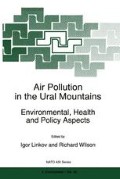Abstract
Two of the principal environmental contamination problems facing the mining regions of the Urals are pollution of air and water by volatile organic chemicals and pollution of air, water and soil by heavy metal wastes from mining and heavy industry such as steel production. Because of the extent of these problems and the large areas affected in the Urals region the use of on-site analysis instruments would provide a powerful tool for making rapid assessments of air, water and soil contamination and for determining where to sample when samples are to be returned to a central laboratory for confirmatory analysis or for further intensive testing.
The first instrument is a very sensitive gas chromatograph using photoionization as the detection principle. This instrument has been widely used in America to perform rapid assessment of air, water and soil contamination from gasoline and other fuel leaks, hazardous waste disposal sites and workplace monitoring to protect workers from unnecessary exposure to volatile chemicals. The instrument has sensitivity to aromatic compounds and ethylene type compounds such as trichloroethylene (TCE) and vinyl chloride (VCM) down to the pictogram range. This results in a sensitivity to benzene and TCE of about 1–10 ppb in air.
Water and soil are analyzed using the simple technique of analyzing headspace in a closed vial for water or by placing soil in a vial with appropriate amounts of methanol or water and analyzing the headspace above the aqueous slurry or by dilution of the methanol extract in water and again using headspace analysis. Using the simple principle of Henry’s Law, water can be analyzed for volatile organic down to the ppt range for aromatics and the low ppb range for alkanes (e.g. carbon tetrachloride, etc).
Detection of volatile contamination from spills or leaks of volatile organic chemicals can be done using another simple field technique. The technique is called “Soil Gas Analysis” and consists of making a small borehole in the area of a suspected contamination incident and sampling the soil gas, using the field gas chromatograph to produce real time data on the nature, spread and concentration of the spilled material in the soil.
Access this chapter
Tax calculation will be finalised at checkout
Purchases are for personal use only
Preview
Unable to display preview. Download preview PDF.
Author information
Authors and Affiliations
Editor information
Editors and Affiliations
Rights and permissions
Copyright information
© 1998 Springer Science+Business Media Dordrecht
About this chapter
Cite this chapter
Spittler, T.M. (1998). The Use of Portable Instrumentation for Assessing Environmental Contamination in the Urals Region of Russia. In: Linkov, I., Wilson, R. (eds) Air Pollution in the Ural Mountains. NATO ASI Series, vol 40. Springer, Dordrecht. https://doi.org/10.1007/978-94-011-5208-2_9
Download citation
DOI: https://doi.org/10.1007/978-94-011-5208-2_9
Publisher Name: Springer, Dordrecht
Print ISBN: 978-94-010-6192-6
Online ISBN: 978-94-011-5208-2
eBook Packages: Springer Book Archive

